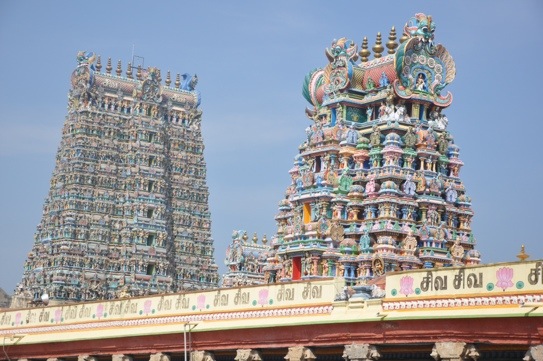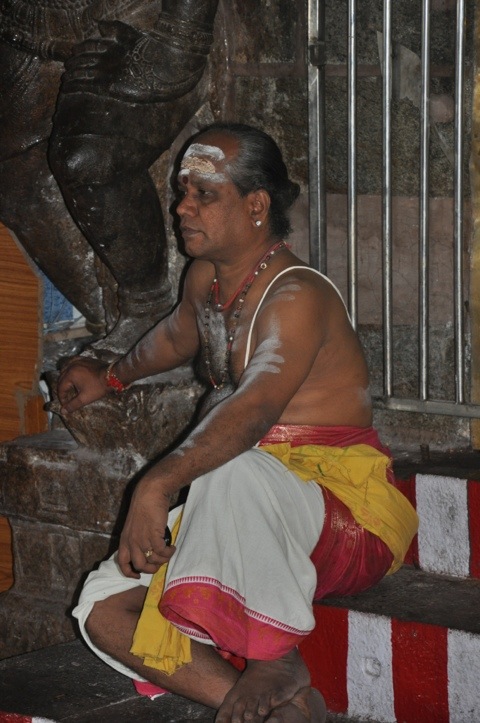We’re dropped by a van a few blocks from our main point of interest today. We walk past houses, swept clean each morning and decorated with rice powder designs that will be eaten by ants by the end of the day.
As we walk, Jay tells us the legend surrounding the origins of Madurai, which involves a story about a couple who has a young girl with three breasts. They are upset about the fact that she’s a girl, and about her deformity. Oh, hell, i can’t remember all the twists and turns, but she kills a demon, marries Shiva, gets back down to two breasts and turns out to be a beautiful fish-eyed goddess (apparently, women with fish eyes are real knock outs), one of the incarnation of Parvathi. As the story goes, Shiva then looks down and drops of nectar fall from his locks, resulting in the city being named Madurai or “The City of Nectar”. So, have you got it?
Ancient Madurai was a center of Tamil culture, famous for its writers and poets, and the history goes back to the 6th century BC when it traded with Greece and Rome. It’s one of the longest continually-occupied cities in the world. The Nayaka Kings laid out the old own in the pattern of a lotus with narrow streets surrounding the Minakshi Temple, which is a temple complex of thirteen buildings constructed over a period of several centuries. Minakshi is the “fish eyed goddess” who is also the consort of Shiva. Shiva has a temple dedicated to him in the complex. Since Minakshi is the presiding goddess, the daily ceremonies are first performed at her shrine and then at the shrine of Shiva. This is a living temple and each shrine has priests performing rituals in front of them, and it’s really the varied life around the temple that is interesting. I’ll try to convey some sense of it through a bunch of photos.
First, there are the impressive towers of the temple
We see a group of men moving a heavy sedan platform on which a statue of Parvathi will be carried around.
There are myriad shops surrounding the temple complex, some selling offerings for pilgrims to bring to the gods. Housed in the remains of a 16th century ruin nestled amongst the decorated pillars and carvings are a remarkable collection of stalls selling everything from silk scarves to pink plastic (Carol bargains for four barrettes for the girls, getting four for $2.40, and causing the rest of us to wait ten minutes to talk the seller down from the outrageous $3 price he’d proposed.)
A group of men and women are clearing cement from an area in the center that will eventually be filled with water, passing heavy containers of cement from one to the next.
People pray.
Priests sit at the shrines, or have tea together after prayers.
Children join their parents and adoring grandparents, some of them brought to be blessed by the gods.
A newly-wed bride is fitted with toe rings.
Shrines are decorated with flowers.
We explore the markets surrounding the temple, passing streets selling an extraordinary variety of items. But there is order in the chaos. The area is a like a huge open air department store, each street dedicated to one particular item – stationery, flowers and fruits, vessels, items used in worship etc. There is even one lane dedicated to bananas – South India boasts over 50 varieties. We are joined by locals, shopping in typically colorful dress.
The highlight of the walk is a stop at a tea shop, where we have delicious “meter” coffees, mixed by the proprietor by pouring them from a height of a meter. Starbucks is due to come to India soon, and we’re guessing that the coffee, which we paid fourteen cents a cup for, will probably go for about $3.50.
We drive a short distance and stop for an excellent lunch at a small hotel restaurant, the return to our hotel for rest, relaxation, blogging, etc., before the evening activities.
Picked up at 6:00, we head for a movie theater. Since we’ve heard so much about the movie-craziness of Tamilnadu, we decide to give it a try, and, as we’re our own bosses, there’s no problem in doing that. Jay has gone ahead to purchase tickets in the VIP area (cost $1.20), which is air conditioned. The movie is Slave Girl, made in 1968, starring MGR, former leader of Tamil, and co-starring the current leader as his leading lady.
The film (and it IS a film, complete with a projector that stops at random times, is a VERY corny, dated story of good versus evil, with lots of sword fights, rescues, flashbacks and singing. We make it until intermission, about an hour and a half.
We head for a hotel for a snack/dinner, which does the trick, and then head to the Minakshi temple for the nightly symbolic putting to bed of Shiva and “Fisheyes”. This involves a procession, with priests carrying an ark-like, small silver house with a black stone (Shiva linga) representing Shiva inside. There is music, fire, prayers, waving of fans, blowing of conch and sprinkling of water. The concept is not unlike the putting to sleep of Mother Ganges each night that we witnessed in Varanasi on our first trip to India, and it’s well worth seeing. hosting information . We go barefoot, as we have in all living Hindu temples that we’ve entered.
Driving home at 10:30, Madurai is still very-much open for business (though not as bustling as it was on our way to the temple at 8:45), as Jay says it will remain well into the wee hours of the morning, unlike any other Indian city. We return to the hotel and forego a drink in favor of retiring.
























Thanks for the great posts, Why do they make the rice powder designs?
Unbelievable! I think these pictures are beautiful and inspiring–the temples!… but also the people and the dress and the yearning for meaning we all have in religious practices…. I am thinking Steppenwolf should do Slave Girl.
Fascinating. Don’t come home, Arnie…these are too good. Truly, thanks for the detailed sharing. You mentioned the ubiquity of cellphones…any sign of Facebook or ‘social networking’? Would that we could all just talk in a bare feet, painted face to painted face!
classic photos, the philosophers on the steps might have been the ancient Greeks….